Kata of GoJu Ryu
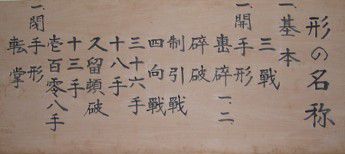
Chojun Miyagi is quoted in saying "It should be known that the secret principles of GoJu Ryu exist within the kata." Morio Higaonna further offered, "Kata" are not simply an exhibition of form. They are a concrete manifestation of techniques which can be transformed at any time to any form. It is in the kata that the essence of karate has assumed a definite form. We should always remember that the kata are a crystallization of the essence of karate and that we should always begin afresh and train hard. It is only through the training of kata that you will reach "gokui", the essential teachings." To simply offer these statements without a substantiated explanation would only add to the number of publications on kata.
Classical Okinawan Karate was developed by ancient masters who understood the "natures of man". These "natures of man" included an intense understandings of what we today call kinesiology, pharmacology, anatomy and physiology, psychology, nutrition and the like. These sciences were understood and applied by the creators of the martial arts two millennia before scientific medicine was founded in the 19th century. This detailed understanding of the inner workings of man were part of the intricate laws and sciences which gave way to one of the most defined and successful methods of medicine still in practice after 2500 years. Without these understandings, Kata is simply a mass of lifeless and meaningless physical movements.
Kata contain obvious external principles including proper body mechanics, maneuvering, distancing, technique placement, evasion, leverage, joint locks, throws and pressure point manipulation. It is the internal manifestations such as energy transference, opening/closing energy gates, clearing the qi (ch'i) channels or meridians, qi cultivation and manipulation, qigong (healing and martial), etc. that are missing from today's modern martial arts. For these reasons, if kata is simplified or altered to either accommodate an instructor's preference or to enhance a tournament competitor's chances, then we lose the true meaning and spirit of kata and thereby diluting the entire system of study.
No longer is "qi" or other aspects of Eastern medicine considered "theories". Since the 1970's, Acupuncture and similar medicines have gone under intensive study and scrutiny by modern scientific groups. From those studies hundreds of papers have been produced. One of the most inclusive publications to date is "Life Force, The Scientific Basis: Breakthrough Physics of Energy Medicine, Healing, Chi and Quantum Consciousness", Claude Swanson, Ph.D.
The practice of Kata in today's martial arts is largely dictated by competition. Aesthetics and audience appeal have replaced functionality. Just as the world returns to a more holistic approach to life, so does the martial arts community seek to understand the origins of these unique arts. The content of this site is to offer such a research venue.
Sanchin - "Three Battles/Conflicts/Challenges"

One of two "heishu " Kata of GoJu Ryu, Sanchin is probably the most misunderstood Kata in all of Karate. In contrast, it is probably the single most valuable training exercise in GoJu Ryu. Like the other Kata of Goju-Ryu, Sanchin can be found in several Chinese arts (San Jan), particularly the southern styles including four styles of Crane Boxing, Dragon Boxing, Tiger Boxing, Lion Boxing, Dog or Ground Boxing and Monk Fist. Sanchin has such aspects as deep, diaphragmatic breathing found in many internal arts as well as external attributes like mechanical alignment and muscular strength. Because many martial artists have little or no understanding of the true history and nature of the Chinese arts from which Okinawan GoJu Ryu has its roots, Sanchin has become little more than an isometric form performed with dangerous tension and improper breathing techniques.
The original Sanchin that Higaonna Sensei learned from RuRuKo (1852-1930) was performed with open hands and with less emphasis on muscle contraction and "energetic" breathing. With the changes brought about by Emperor Meiji (Meiji Restoration Period 1888-1912), Higaonna Sensei changed the open hands to closed fists as the martial meaning was no longer emphasized. Later Miyagi Sensei would again alter the Kata in pattern alone.
Sanchin translates as "3 Battles" or "3 Conflicts". This has many meanings. First it refers to the struggle to control the body under physical fatigue. With fatigue the mind begins to lose focus and thus the spirit begins to diminish as well. Therefore Sanchin develops discipline, determination, focus, perseverance and other mental attributes. The Chinese refer to this as Shen (spirit), Shin (mind) and Li (body). Another possible interpretation refers to the "Three Burners" of the body as described in Traditional Chinese Medicine (TCM).
Gekisai Dai Ichi / Gekisai Dai Ni - "Attack & Destroy"

The Gekisai Kata were formulated by Chojun Miyagi Sensei in 1940 as a form of physical exercise for high school boys and to help popularize GoJu Ryu among the public of Okinawa. In 1948, after WWII, Miyagi Sensei began to teach the Gekisai Kata in depth as a regular part of GoJu Ryu in his own dojo. Until this time, Sanchin was the first Kata taught in GoJu Ryu. Sanchin is physically and mentally a demanding Kata and requires a great deal of time and patience to learn and perform properly. The Gekisai Kata however are easier to learn and perform, and contain dynamic techniques which are more attractive to young people. These Kata contain the same kanji for "sai" found in Saifa. This would suggest that even though these Kata were designed primarily as a form of exercise, Miyagi Sensei included his understanding of combat as part of their makeup.
Saifa - "Rip and Tear Apart"
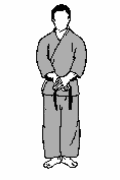
Saifa is the first of the classical combative Kata taught in GoJu Ryu. GoJu Ryu's Kata origins come from the martial arts taught in the Fuzhou area of southern China, largely Crane and Xingyi/Baqua as well as other internal and external martial arts. Kanryo Higaonna Sensei was taught this Kata, along with the other Kata of GoJu Ryu, while he studied in China from 1863-1881 under the direction of RuRuKo (Xie Zhongxiang in Chinese) and others. These Kata and martial strategies would become the basis of the the quanfa of Higaonna Sensei, which later Miyagi Sensei would call GoJu Ryu. From an understanding of the grappling and striking techniques of this Kata, Saifa can be interpreted to mean grabbing and tearing of tissue in close-quartered combat.
Seiyunchin - "Control/Suppress and Pull"
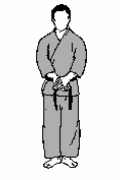
The name Seiyunchin implies the use of techniques to off balance, throw and grapple. It is this understanding that imparts the original intentions of the Kata before the sport alignment of modern Karate. Seiyunchin contains close-quartered striking, sweeps, take-downs and throws. Though the Kata itself is void of kicks, many practitioners make the grave mistake by missing the opportunity to apply any leg technique. Though almost invisible to the untrained eye, the subtleness of "ashi barai" and "suri ashi" can represent foot sweeps, parries and traps.
Shisochin - "Four Directions/Gates of Conflict/Attack"
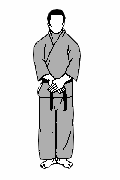
Shisochin translates as "Four Gates" or "Four Directions of Conflict". To leave it at that discounts a truer understanding. The third kanji is the same found in Sanchin and Seiyunchin, which translates as "battle" or "conflict". This lends to a deeper definition of its meaning. The idea of four directions can come from the performance of the four shotei in four directions. It can also represent the four elements represented in Chinese medicine (Acupuncture is one) of Wood, Fire, Metal and Water with man representing Earth. Since this was the science and culture of that period in China when Higaonna and Miyagi both studied in Fuzhou, it would be a great oversight to discount this aspect as a very probable explanation of the Kata's name and martial intent.
Sanseiru - "36 Hands"
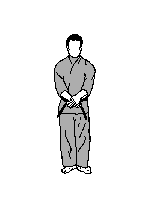
Sanseiru is unique as Miyagi Sensei studied this Kata under a direct student of RuRuKo during his studies in Fuzhou, China beginning in 1916. An explanation of the name Sanseru and the other numerically named Kata is that they refer to a systematic method and understanding of certain groupings of vital acupressure points. It is this science that the martial arts was based upon and developed. Feng Yiquan, who lived during the Ming Dynasty (1522-67) developed this particular method of using variations of "36" forbidden points to defeat his opponents. Other disciples of Feng created other quans expanding the number to 72 and ultimately 108. Sanseru is found in the following styles of Chinese Boxing: Crane, Tiger, and Dog.
Seipai - "18 Hands"

The reference to "18" in naming this Kata has a couple of interpretations. Like Sanseiru, the most apparent and most meaningful in the naming of Seipai is again from the martial arts development and the use of attacking pressure points. 18 is one half of 36 suggesting that perhaps an alternative set of attacks and defenses of preferred techniques and strategies from the original Sanseru 36. Sepai is found in Monk Boxing.
Kururunfa - "Holding Ground"
GoJu Ryu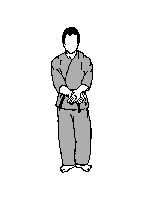
Kururunfa epitomizes the ideals of Go-"hard and Ju-"soft". Stance transitions are quick and explosive while the hands techniques are employed using "muchimi" or a heavy, sticky movement. As in the other kata of GojJu yu, it is quite evident that grappling and close-quartered fighting is the favored fighting style. The same kanji "fa"is found in Saifa. Again, this would suggest a strong emphasis on grappling. Where most other styles' Kata concentrate on "block/punch", it is obvious from the unique techniques that this is not the case with GoJu Ryu..
Seisan - "13 Hands"
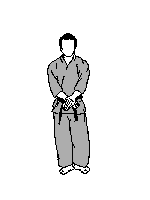
Seisan, Sanseiru and Seipai all share the kanji "se". This may well be a Chinese dialect of the Okinawan term "te" or "fighting hand", referring to life-protection techniques. To better understand these Kata requires a more defined understanding of the language and culture of the people from which these Kata originated.
Seisan is believed to be the oldest of all Okinawan Goju-Ryu Kata. There is a version of Seisan practiced in the Shorin schools, but in comparison, the GoJu Ryu version is longer and much more complex. Sesan is practiced in the following styles of Chinese Boxing: Dragon, Lion and Monk Fist.
Suparinpei - "108 Hands"
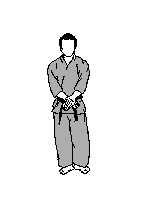
Suparinpei is the most advanced Kata in GoJu Ryu. It contains the greatest number of techniques and variations. Suparinpei is deceptive in that it appears simple in execution but when combined with transitions and changing tempos, it is only surpassed by Sanchin in technical difficulty and understanding.
Once again, the number "108" is suggested to have origins in Buddhism and can represent the "108 sins of man". On the Chinese New Year, temple bells are rung 108 times to "drive away the evils of man". It is believed these named associations with Buddhism is based upon the lack of factual knowledge of the true nature of these quan.
Secondly, with the cultural changes that took place in China during and after the Boxing Rebellion (1900) and the fall of the Qing Dynasty (1644-1911), little emphasis was placed on learning such complex arts. Most who learned the fighting arts after this time, did so as a means of exercise, recreation or artistic performance. In addition, the wide-spread use of firearms reduced the need and effectiveness for hand-to-hand combat as a means to civil defense. Suparinpei is found in the following styles of Chinese Boxing: Dragon, Tiger & Monk Fist.
Tensho - "Turning Palms"
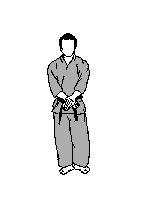
The second "heishu" kata in GoJu Ryu, Tensho is derived from the Chinese form "Rokkishu". Unlike Sanchin, which is almost identical to its Chinese counterpart, Tensho is uniquely Okinawan. From his understanding of the Kata of GoJu Ryu and the "nature of man", Miyagi Sensei developed Tensho to further complete his GoJu Ryu where Sanchin left off. Tensho has many of the same principles of Sanchin but goes further to include more intricate concepts of the techniques of GoJu Ryu. These concepts expressly come alive in kakie, which in advanced training, breathes life into the bunkai of the Kata of GoJu Ryu.
The most notable difference between Sanchin and that of Tensho is that the breathing is explicitly different than that of Sanchin. The breathing of Tensho is not "hard" and external like Sanchin. The breath is internalized distinctively different and to the uneducated will appear to be the same as Sanchin.
The term "heishu" translates as "closed". As with every aspect of Okinawan Karate, there is more than one definition. First, "heishu" can refer to muscle contraction and "ibuki" style breathing unique to Sanchin and Tensho. Secondly, it can imply the restriction and specific direction of energies within the energy pathways of the body, both superficial and deep. The other 10 Kata are referred to as "kaishu" or "open", as they are free of constant muscle contraction and breathing is "normal".
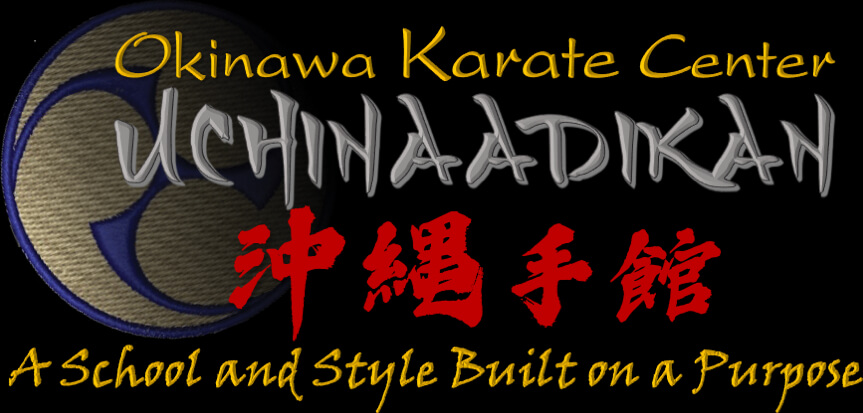


 ·
· 